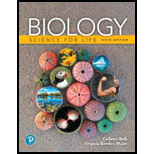
Pearson eText Biology: Science for Life -- Instant Access (Pearson+)
6th Edition
ISBN: 9780135214084
Author: Colleen Belk, Virginia Maier
Publisher: PEARSON+
expand_more
expand_more
format_list_bulleted
Question
Chapter 19, Problem 2AAATB
Summary Introduction
To determine:
The passage of food when it goes into the wrong path.
Introduction:
The pharynx is present in the throat area which is the common passage for air and food. It is divided into trachea and esophagus. Trachea is the part of the respiratory system and esophagus is the part of the
Expert Solution & Answer
Want to see the full answer?
Check out a sample textbook solution
Students have asked these similar questions
The process by which the products of digestion pass from the lumen of the gastrointestinal tract into the blood or lymph is:
absorption
defecation
digestion
peristalsis
In the digestive system, what is the correct order from when you eat food to where it exits? (e.g. mouth, throat, esophagus, stomach, duodenum, ilium, sacrum, anus,)
Why does digestion have to come before absorption?
Chapter 19 Solutions
Pearson eText Biology: Science for Life -- Instant Access (Pearson+)
Knowledge Booster
Learn more about
Need a deep-dive on the concept behind this application? Look no further. Learn more about this topic, biology and related others by exploring similar questions and additional content below.Similar questions
- Figure 34.11 Which of the following statements about the digestive system is false? Chyme is a mixture of food and digestive juices that is produced in the stomach. Food enters the large intestine before the small intestine. In the small intestine, chyme mixes with bile, which emulsifies fats. The stomach is separated from the small intestine by the pylloric sphincter.arrow_forwardFigure 34.19 Which of the following statements about digestive processes is true? Amylase, maltaseT and lactase in the mouth digest carbohydrates. Trypsin and lipase in the stomach digest protein. Bile emulsifies lipids in the small intestine. No food is absorbed until the small intestine.arrow_forwardWhat are the main functions of the stomach? What roles do enzymes and hormones play?arrow_forward
- Digestion takes place in a long tube-like canal called the alimentary canal, or the digestive tract. Food travels through these organs in the following order: 1) Mouth, gullet, stomach, small intestine,large intestine and rectum 2) Mouth, oesophagus, stomach, large intestine,small intestine and rectum 3) Mouth, stomach, oesophagus, small intestine,large intestine and rectum 4) Mouth, stomach, gullet, small intestine,large intestine and rectumarrow_forwardwhich substance bring excess lipoprotein in the bloodstream back to the liver? a) high density lipoproteins b)low density lipoproteins c)very low density lipoproteins both b and c all of the abovearrow_forwarddescribe the passage of food from the time from when it enters your mouth until it reaches the end in order? what does it go through? what chambers (the mouth, esophagus, stomach, etc.)? what gates (to enter the mouth you have to go through the lips)? what sphincters? food has to go through various places, what is happening to the food?arrow_forward
- carbohydrate digestion in the oral cavity involves which of the following? Give two answers tongue, teeth, amylase, salivary glandsarrow_forwarda) What is the general function of all enzymes that are involved in the digestive process.b) Use the Table below to summarise the function of 6 named digestive enzymes that are either secreted from specific regions of the gastrointestinal system, or part of the intestinal brush border. Enzyme Site of secretion / Action Function (to include substrate and product formed)arrow_forwardAchlorhydria is a condition in which the stomach stops producinghydrochloric acid and other secretions. What effect would achlorhydriahave on the digestive process? On red blood cell count?arrow_forward
- Food comes into contact with several anatomical structures as it passes through the body. Which of the following is INCORRECT with respect to the approximate order of passage of food through the gut? Question 16 options: oropharynx > epiglottis > jejunum > ileocecal valve > anal sphincter esophagus > duodenum > ilium > ascending colon > anal sphincter oral cavity > cardiac sphincter > pyloric sphincter > ileocecal valve > anus epiglottis > stomach > jejunum > sigmoid colon > anus lips > cardiac sphincter > pyloric valve > ileocecal valve > anusarrow_forwardFrom beginning to end, what is the correct order of places where food goes through on its way through the body of the following?: anus, colon, ileum, duodenum, esophagus, mouth, pharynx, stomach, jejunum, cecum, rectumarrow_forwardHow does gastrointestinal tract evade dehydration? 1) Alternating wave-like contraction and relaxatio of the oral (mouth) muscles reabsorbs water which will be transported to the urinary system 2) water is an important digestive enzyme in the stomach. 3) Normal peristaltic movements in the large intestine ensure reabsorption of water that will be delivered to the circulatory system. 4) the water we drink will be mostly absord by the blood vessels attached to the esophagus and stomach. Skip questionarrow_forward
arrow_back_ios
SEE MORE QUESTIONS
arrow_forward_ios
Recommended textbooks for you
 Human Physiology: From Cells to Systems (MindTap ...BiologyISBN:9781285866932Author:Lauralee SherwoodPublisher:Cengage Learning
Human Physiology: From Cells to Systems (MindTap ...BiologyISBN:9781285866932Author:Lauralee SherwoodPublisher:Cengage Learning Comprehensive Medical Assisting: Administrative a...NursingISBN:9781305964792Author:Wilburta Q. Lindh, Carol D. Tamparo, Barbara M. Dahl, Julie Morris, Cindy CorreaPublisher:Cengage LearningEssentials of Pharmacology for Health ProfessionsNursingISBN:9781305441620Author:WOODROWPublisher:Cengage
Comprehensive Medical Assisting: Administrative a...NursingISBN:9781305964792Author:Wilburta Q. Lindh, Carol D. Tamparo, Barbara M. Dahl, Julie Morris, Cindy CorreaPublisher:Cengage LearningEssentials of Pharmacology for Health ProfessionsNursingISBN:9781305441620Author:WOODROWPublisher:Cengage

Human Physiology: From Cells to Systems (MindTap ...
Biology
ISBN:9781285866932
Author:Lauralee Sherwood
Publisher:Cengage Learning




Comprehensive Medical Assisting: Administrative a...
Nursing
ISBN:9781305964792
Author:Wilburta Q. Lindh, Carol D. Tamparo, Barbara M. Dahl, Julie Morris, Cindy Correa
Publisher:Cengage Learning

Essentials of Pharmacology for Health Professions
Nursing
ISBN:9781305441620
Author:WOODROW
Publisher:Cengage
Cancer Types SIMPLY explained! MEMORIZE them QUICKLY and EASILY!; Author: CancerEdInstitute;https://www.youtube.com/watch?v=dEBi-yvSWmQ;License: Standard Youtube License